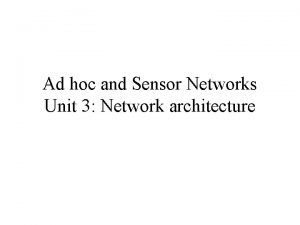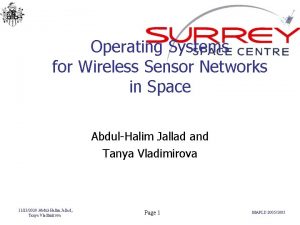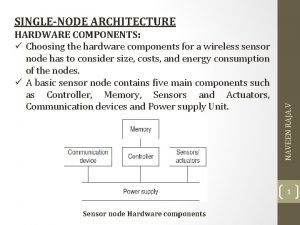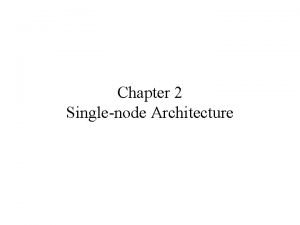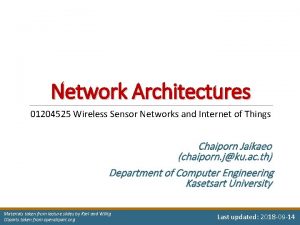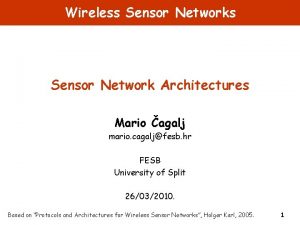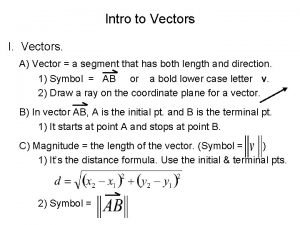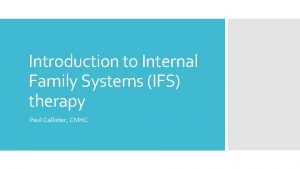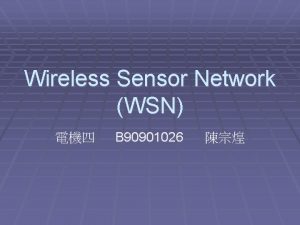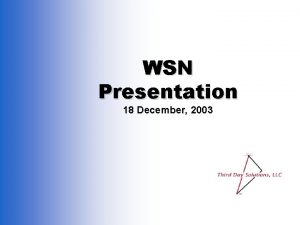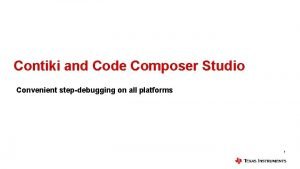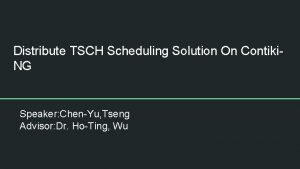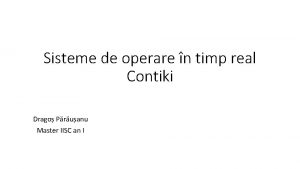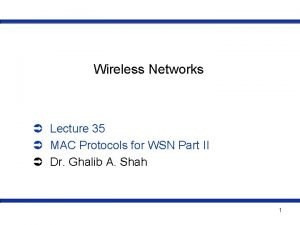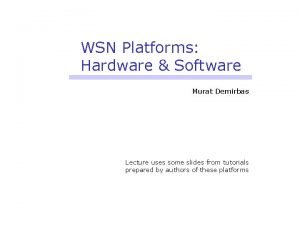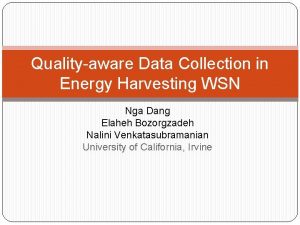Contiki OS Intro Contiki is a WSN platform























- Slides: 23

Contiki OS

Intro • Contiki is a WSN platform that provides software and hardware. • The operating system (OS) in Contiki uses Protothread, which combines multithreading and event-driven programming. • On the hardware side, the Contiki project provides hardware schemes to build Contiki boards. • official website for Contiki http: //www. contiki-os. org. • The programming model of the Contiki platform implements a preemptive multithreading architecture and an event-driven model. • The Contiki programming language uses C syntax for writing programs. • Contiki provides hardware abstractions that encapsulate hardware complexity.

General Architecture

Architecture - Development • Kernel, the program loader, the language run-time, and the communication service are static modules within the ROM of Contiki OS. • All user programs will be loaded into Loaded Program. Only the kernel and the communication service will be used by the Contiki OS RAM. • Contiki uses a GCC compiler to compile C source code files. We develop Contiki applications written in *. c files. • After they are compiled, we obtain the binary file. • We also can run a C program on the Contiki simulator to verify program behaviors.

Development steps

Hello world … include "contiki. h" #include <stdio. h> /* For printf() */ /*------------------------------*/ PROCESS(hello_world_process, "Hello world process"); AUTOSTART_PROCESSES(&hello_world_process); /*------------------------------*/ PROCESS_THREAD(hello_world_process, ev, data) { PROCESS_BEGIN(); printf("Hello, worldn"); PROCESS_END(); }

Contiki-NG Programming Model • Contiki-NG uses the C programming language, which is componentdriven. • You build some components and then connect each component. • Most WSN motes work in sleep mode. If there is any task to be executed, the program will perform the task through hardware interrupts. • If the task is completed, the Contiki-NG program will go back to sleep mode.

System overview • A running Contiki system consists of the kernel, libraries, the program loader, and a set of processes. • A process may be either an application program or a service. • A service implements functionality used by more than one application process. • All processes, both application programs and services, can be dynamically replaced at run-time. • Communication between processes always goes through the kernel. • The kernel does not provide a hardware abstraction layer, but lets device drivers and applications communicate directly with the hardware. • A process is defined by an event handler function and an optional poll handler function. • The process state is held in the process' private memory and the kernel only keeps a pointer to the process state. • All processes share the same address space and do not run in different protection domains. • Interprocess communication is done by posting events.

Core part • A Contiki system is partitioned into two parts: the core and the loaded programs as shown previously. The partitioning is made at compile time and is specific to the deployment in which Contiki is used. • Typically, the core consists of the Contiki kernel, the program loader, the most commonly used parts of the language run-time and support libraries, and a communication stack with device drivers for the communication hardware. • The core is compiled into a single binary image that is stored in the devices prior to deployment. • The core is generally not modified after deployment, even though it should be noted that it is possible to use a special boot loader to overwrite or patch the core.

Program loading • Programs are loaded into the system by the program loader. The program loader may obtain the program binaries either by using the communication stack or by using directly attached storage such as EEPROM. • Typically, programs to be loaded into the system are first stored in EEPROM before they are programmed into the code memory.

Kernel structure • The Contiki kernel consists of a lightweight event scheduler that dispatches events to running processes and periodically calls processes' polling handlers. • All program execution is triggered either by events dispatched by the kernel or through the polling mechanism. • The kernel does not preempt an event handler once it has been scheduled. Therefore, event handlers must run to completion. • Event handlers may use internal mechanisms to achieve preemption. • The kernel supports two kind of events: asynchronous and synchronous events. • Asynchronous events are a form of deferred procedure call: asynchronous events are enqueued by the kernel and are dispatched to the target process some time later. • Synchronous events are similar to asynchronous but immediately causes the target process to be scheduled. • Control returns to the posting process only after the target has finished processing the event. This can be seen as an inter-process procedure call.

Kernel structure (cont. ) • In addition to the events, the kernel provides a polling mechanism. Polling can be seen as high priority events that are scheduled inbetween each asynchronous event. • Polling is used by processes that operate near the hardware to check for status updates of hardware devices. • When a poll is scheduled all processes that implement a poll handler are called, in order of their priority. • The Contiki kernel uses a single shared stack for all process execution. • The use of asynchronous events reduce stack space requirements as the stack is rewound between each invocation of event handlers.

Scheduling policy • All event scheduling in Contiki is done at a single level and events cannot preempt each other. • Events can only be preempted by interrupts. Normally, interrupts are implemented using hardware interrupts but may also be implemented using an underlying real-time executive. • The latter technique has previously been used to provide real-time guarantees for the Linux kernel. • In order to be able to support an underlying real-time executive, Contiki never disables interrupts. Because of this, Contiki does not allow events to be posted by interrupt handlers as that would lead to race-conditions in the event handler. • Instead, the kernel provides a polling flag that it used to request a poll event. The flag provides interrupt handlers with a way to request immediate polling.

Loadable programs • Loadable programs are implemented using a run-time relocation function and a binary format that contains relocation information. • When a program is loaded into the system, the loader first tries to allocate sufficient memory space based on information provided by the binary. • If memory allocation fails, program loading is aborted. • After the program is loaded into memory, the loader calls the program's initialization function. The initialization function may start or replace one or more processes.

Services (1) • In Contiki, a service is a process that implements functionality that can be used by other processes. • A service can be seen as a form of a shared library. • Services can be dynamically replaced at run-time and must therefore be dynamically linked. • Typical examples of services includes communication protocol stacks, sensor device drivers, and higher level functionality such as sensor data handling algorithms.

Services (2) Services are managed by a service layer conceptually situated directly next to the kernel. The service layer keeps track of running services and provides a way to find installed services. A service is identified by a textual string that describes the service. The service layer uses ordinary string matching to querying installed services. A service consists of a service interface and a process that implements the interface. The service interface consists of a version number and a function table with pointers to the functions that implement the interface. • Application programs using the service use a stub library to communicate with the service. • The stub library is linked with the application and uses the service layer to find the service process. • Once a service has been located, the service stub caches the process ID of the service process and uses this ID for all future requests. • • •

Services (3)

Services (4) • Programs call services through the service interface stub and need not be aware of the fact that a particular function is implemented as a service. • The first time the service is called, the service interface stub performs a service lookup in the service layer. • If the specified service exists in the system, the lookup returns a pointer to the service interface. • The version number in the service interface is checked with the version of the interface stub. In addition to the version number, the service interface contains pointers to the implementation of all service functions. • The function implementations are contained in the service process. • If the version number of the service stub match the number in the service interface, the interface stub calls the implementation of the requested function.

Service Replacement • Services may be dynamically loaded and replaced in a running Contiki system. • Because the process ID of the service process is used as a service identifier, it is crucial that the process ID is retained if the service process is replaced. For this reason, the kernel provides special mechanism for replacing a process and retaining the process ID. • When a service is to be replaced, the kernel informs the running version of the service by posting a special event to the service process. In response to this event, the service must remove itself from the system. • Many services have an internal state that may need to be transferred to the new process. The kernel provides a way to pass a pointer to the new service process, and the service can produce a state description that is passed to the new process. The memory for holding the state must be allocated from a shared source, since the process memory is deallocated when the old process is removed.

Comms support • In Contiki, communication is implemented as a service in order to enable run-time replacement. Implementing communication as a service also provides for multiple communication stacks to be loaded simultaneously. • Communication services use the service mechanism to call each other and synchronous events to communicate with application programs. Because synchronous event handlers are required to be run to completion, it is possible to use a single buffer for all communication processing. With this approach, no data copying has to be performed. • A device driver reads an incoming packet into the communication buffer and then calls the upper layer communication service using the service mechanisms. • The communication stack processes the headers of the packet and posts a synchronous event to the application program for which the packet was destined. • The application program acts on the packet contents and optionally puts a reply in the buffer before it returns control to the communication stack. • The communication stack prepends its headers to the outgoing packet and returns control to the device driver so that the packet can be transmitted.

Communication stack implementation

Preemptive multi-threading • In Contiki, preemptive multi-threading is implemented as a library on top of the event-based kernel. • The library is optionally linked with applications that explicitly require a multi-threaded model of operation. • The library is divided into two parts: a platform independent part that interfaces to the event kernel, and a platform specific part implementing the stack switching and preemption primitives. • Usually, the preemption is implemented using a timer interrupt that saves the processor registers onto the stack and switches back to the kernel stack.

MT API
 Mediation device protocol in wsn
Mediation device protocol in wsn Wsn operating systems
Wsn operating systems Apa itu wsn
Apa itu wsn Collaborative processing in wsn
Collaborative processing in wsn Optimization goals and figures of merit in wsn
Optimization goals and figures of merit in wsn Single node architecture in wsn
Single node architecture in wsn Wsn
Wsn Wsn tunneling
Wsn tunneling Medical terms composed of word parts are
Medical terms composed of word parts are Introduction and conclusion paragraphs
Introduction and conclusion paragraphs Business ethics 2015
Business ethics 2015 Intro to vectors
Intro to vectors Adjective adverb clause
Adjective adverb clause Andrew ng intro machine learning
Andrew ng intro machine learning Intro
Intro Paragraph hooks
Paragraph hooks Contoh intro power point
Contoh intro power point Intro paragraph for argumentative essay
Intro paragraph for argumentative essay Intro to ifs
Intro to ifs Mr kennedy intro
Mr kennedy intro Intro for performance task
Intro for performance task Intro to offensive security
Intro to offensive security Solar system intro
Solar system intro Reference as a theory of meaning
Reference as a theory of meaning
